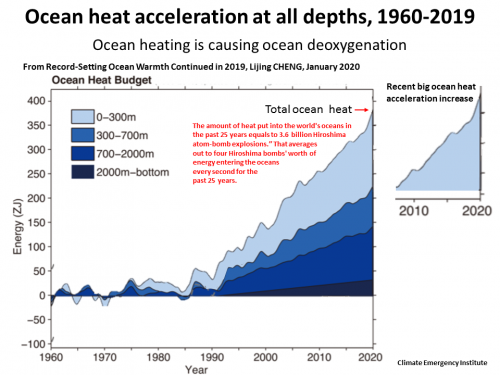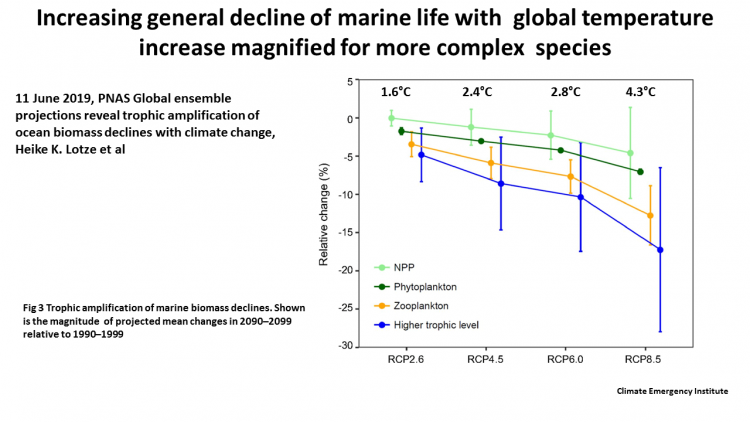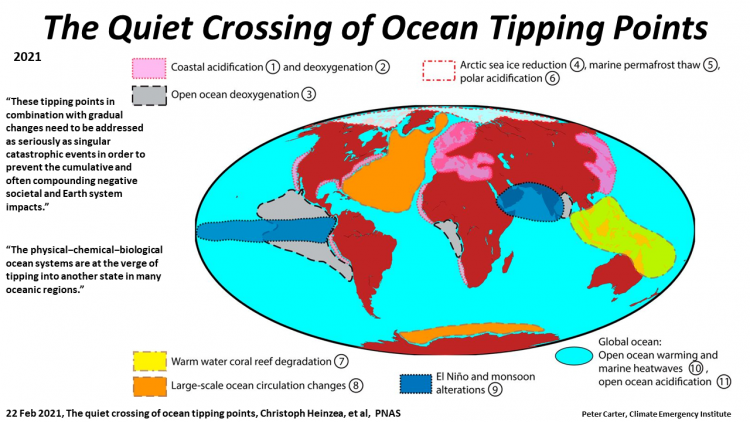12 Oct 2015 Global marine analysis suggests food chain collapse
Climate Change & Oceans
Ocean acidification is at a 20 million year high and the rate is at a 300 million year high (see Jelle Bijma 2013)
Atmospheric GHG Pollution Impacts on the World's Oceans
July 2015 Science Consensusv. Immediate and substantial reduction of CO2 emissions is required to prevent the massive and mostly irreversible impacts on ocean ecosystems and their services
The oceans that collectively make up the World Ocean play a fundamental role in the global climate system.
According to a research paper published in Nature Climate Change (Aug 2013), ocean life is being forced to migrate faster than life on land due to climate induced changes that are occurring in the marine environment.
There is a clear consensus from the many scientific statements that are now being made about ocean acidification, that rapid, unprecedented changes are occurring (EPOCA statement). According to the NOAA on ocean acidity, the oceans are more acid than they have ever been over the past 20 million years. In 50 years acidity will increase 120% if no emergency response is initiated.
Ocean acidification is occurring faster today than it has over the past 300 million years.
The oceans are being warmed and acidified forever. Scientists expect that the ocean will eventually take up about 85% of anthropogenic CO2- because the ocean takes ~1000 years to mix, this process will take many hundreds to thousands of years (see Carbon and Climate).
The ocean (World Ocean) impact due to atmospheric CO2 pollution is often forgotten in climate change considerations. Our planet Earth is in effect the Ocean planet because the World Ocean provides an incomparably larger habitat for life than the land.
The oceans are the ultimate controller of the climate system. By absorbing CO2 from the air at the sea surface, carbon is combined with calcium by shell bearing marine organisms and sinks to the ocean floor when these organisms die, and in so doing gets locked up in ocean sediments. Over ages of time the calcium compressed in the sea floor sediment returns to the land as limestone and dolomite rock. This is the ultra-long ocean carbon cycle.
Global heating from GHG emissions is largely ocean heating because the oceans have taken up over 90% of greenhouse gas heat (NOAA) that has been added to the lower atmosphere. Ocean heat content has been rapidly increasing-and accelerating since 2010.
The key reason as to why the global warming surface temperature increase has stalled is because, quite suddenly, near surface ocean heat is being transported into the deep ocean to such an extent, which in actual fact means that global heating has accelerated further.
This greenhouse gas heat that is stored in our oceans is a large reason for our future commitment to much more land surface warming than we have experienced to date.
Due to the ocean heat lag, the heat taken up by the oceans is the primary cause of climate change inertia. Even if emissions were to stop, the ocean would continue to add heat to the planets surface. This is the ocean heat lag warming future commitment and also partly explains why global warming persists for over a thousand years.
The warming of the Ocean was initially limited to the surface water, but research on ocean heat content now shows that over the past decade there has been a large increase in heat transfer to the deep ocean. This explains the stalled global average surface warming, and in fact means global heating has increased.
Warming of the surface water causes bleaching and death of corals reefs, which play a fundamental role in supporting ocean biodiversity.
Deeper ocean warming slows currents that play a crucial role in bringing oxygen and food to marine creatures, and also in ocean cleansing. Consequently, deep hypoxic ocean dead zones are forming and expanding.
It is estimated that the oceans have absorbed as much as 40% of the emitted CO2 through the vast expanse of surface waters. CO2 gas dissolves in sea water to form carbonic acid, which results in ocean acidification. Acidification affects the ability of marine organisms to calcify - some shell forming species are showing signs of decalcification - and damages the biological carbon pump essential for assimilating and sinking carbon. Ocean acidification is yet another reason why atmospheric carbon pollution is catastrophically dangerous.
July 2015 Science Consensusv. Immediate and substantial reduction of CO2 emissions is required to prevent the massive and mostly irreversible impacts on ocean ecosystems and their services
The oceans that collectively make up the World Ocean play a fundamental role in the global climate system.
According to a research paper published in Nature Climate Change (Aug 2013), ocean life is being forced to migrate faster than life on land due to climate induced changes that are occurring in the marine environment.
There is a clear consensus from the many scientific statements that are now being made about ocean acidification, that rapid, unprecedented changes are occurring (EPOCA statement). According to the NOAA on ocean acidity, the oceans are more acid than they have ever been over the past 20 million years. In 50 years acidity will increase 120% if no emergency response is initiated.
Ocean acidification is occurring faster today than it has over the past 300 million years.
The oceans are being warmed and acidified forever. Scientists expect that the ocean will eventually take up about 85% of anthropogenic CO2- because the ocean takes ~1000 years to mix, this process will take many hundreds to thousands of years (see Carbon and Climate).
The ocean (World Ocean) impact due to atmospheric CO2 pollution is often forgotten in climate change considerations. Our planet Earth is in effect the Ocean planet because the World Ocean provides an incomparably larger habitat for life than the land.
The oceans are the ultimate controller of the climate system. By absorbing CO2 from the air at the sea surface, carbon is combined with calcium by shell bearing marine organisms and sinks to the ocean floor when these organisms die, and in so doing gets locked up in ocean sediments. Over ages of time the calcium compressed in the sea floor sediment returns to the land as limestone and dolomite rock. This is the ultra-long ocean carbon cycle.
Global heating from GHG emissions is largely ocean heating because the oceans have taken up over 90% of greenhouse gas heat (NOAA) that has been added to the lower atmosphere. Ocean heat content has been rapidly increasing-and accelerating since 2010.
The key reason as to why the global warming surface temperature increase has stalled is because, quite suddenly, near surface ocean heat is being transported into the deep ocean to such an extent, which in actual fact means that global heating has accelerated further.
This greenhouse gas heat that is stored in our oceans is a large reason for our future commitment to much more land surface warming than we have experienced to date.
Due to the ocean heat lag, the heat taken up by the oceans is the primary cause of climate change inertia. Even if emissions were to stop, the ocean would continue to add heat to the planets surface. This is the ocean heat lag warming future commitment and also partly explains why global warming persists for over a thousand years.
The warming of the Ocean was initially limited to the surface water, but research on ocean heat content now shows that over the past decade there has been a large increase in heat transfer to the deep ocean. This explains the stalled global average surface warming, and in fact means global heating has increased.
Warming of the surface water causes bleaching and death of corals reefs, which play a fundamental role in supporting ocean biodiversity.
Deeper ocean warming slows currents that play a crucial role in bringing oxygen and food to marine creatures, and also in ocean cleansing. Consequently, deep hypoxic ocean dead zones are forming and expanding.
It is estimated that the oceans have absorbed as much as 40% of the emitted CO2 through the vast expanse of surface waters. CO2 gas dissolves in sea water to form carbonic acid, which results in ocean acidification. Acidification affects the ability of marine organisms to calcify - some shell forming species are showing signs of decalcification - and damages the biological carbon pump essential for assimilating and sinking carbon. Ocean acidification is yet another reason why atmospheric carbon pollution is catastrophically dangerous.
The many damaging ocean effects of atmospheric GHG pollution The Ocean Foundation

Today's accelerating
ocean warming, acidification &
de-oxygenation
is a dire Planetary Emergency
ocean warming, acidification &
de-oxygenation
is a dire Planetary Emergency

CLIMATE EMERGENCY INSTITUTE
July 2015 Science Consensus
Contrasting futures for ocean and society from different CO2 emissions scenarios
Contrasting futures for ocean and society from different CO2 emissions scenarios
Research July 2015 Dramatic changes to phytoplankton from acidification
16 August 2015 World's coral reefs doomed even if the Dec 2015 UN Paris Climate Conference is successful.
15 Jan 2015 Ocean Life Faces Mass Extinction, Broad Study Says.
VIDEO Nov 2015 Acidifiying Southern Ocean
1 Feb 2016. Phytoplankton disappearing from the Indian Ocean due to warming stratification.
27 April 2016. Deoxygenation- climate change threatens marine life
June 2015. WARMING CATASTROPHIC COLLAPSE PHYTOPLANKTON
Mathematical Modelling of Plankton–Oxygen Dynamics Under the Climate Change.
Mathematical Modelling of Plankton–Oxygen Dynamics Under the Climate Change.
2016 e-book Overview
UN 1st Global Marine Assessment
UN 1st Global Marine Assessment
Global warming will expand both coastal dead zones and deep ocean dead zones
16 March 2017 Coral reefs are doomed without immediate measures (global emissions decline) on global warming
Australia Climate Council July 2018 Extreme ocean temperatures occurring every two years ... 'effectively destroying the Great Barrier Reef'
Australia Climate Council July 2018 Extreme ocean temperatures occurring every two years ... 'effectively destroying the Great Barrier Reef'
Oct 2017 BIOACID larges study shows that ocean acidification along with other ocean effects of atmospheric GHG pollution puts practically all marine life at risk.
Oceans have absorbed 30% of CO2 emissions.
Oceans have absorbed 30% of CO2 emissions.
3 July 2015 '...impacts on key marine and coastal organisms, ecosystems, and services are already detectable, and several will face high risk of impacts well before 2100, even under
low-emissions scenario. These impacts will occur across all latitudes. Immediate and substantial reduction of CO2 emissions is required to prevent the massive and mostly irreversible impacts on ocean ecosystems and their services
low-emissions scenario. These impacts will occur across all latitudes. Immediate and substantial reduction of CO2 emissions is required to prevent the massive and mostly irreversible impacts on ocean ecosystems and their services
2017 Ocean Deeply Ocean warming and de-oxygenation will impact phytoplankton - that make most of our oxygen. Ocean acidification and warming will impact zooplankton essential for ocean life and for sinking carbon.
Sea surface temperature tracker

Triple Deadly Ocean Assaults:
o Heating
o Acidification
o De-oxygenation
o Heating
o Acidification
o De-oxygenation

Ocean Deox Feedbacks. Deoxygenated deeper ocean waters produce greenhouse gases such as nitrous oxide, carbon dioxide and methane

5 Aug 2021 Observation,,, for a collapse of the Atlantic Meridional Overturning Circulation
17 June 2015. Growing feedback from ocean carbon to climate
21 Sept 2021, An Overview of Ocean Climate Change Indicators (multiple)
5 Oct 2021 State of World's Coral Reefs 2020, 2009- 2018 14% coral loss
17 December 2020, The quiet crossing of ocean tipping points, Christoph Heinze et al
Abstract
Abstract
Anthropogenic climate change profoundly alters the ocean’s environmental conditions, which, in turn, impact marine ecosystems. Some of these changes are happening fast and may be difficult to reverse. The identification and monitoring of such changes, which also includes tipping points, is an ongoing and emerging research effort. Prevention of negative impacts requires mitigation efforts based on feasible research-based pathways. Climate-induced tipping points are traditionally associated with singular catastrophic events (relative to natural variations) of dramatic negative impact. High-probability high-impact ocean tipping points due to warming, ocean acidification, and deoxygenation may be more fragmented both regionally and in time but add up to global dimensions. These tipping points in combination with gradual changes need to be addressed as seriously as singular catastrophic events in order to prevent the cumulative and often compounding negative societal and Earth system impacts.